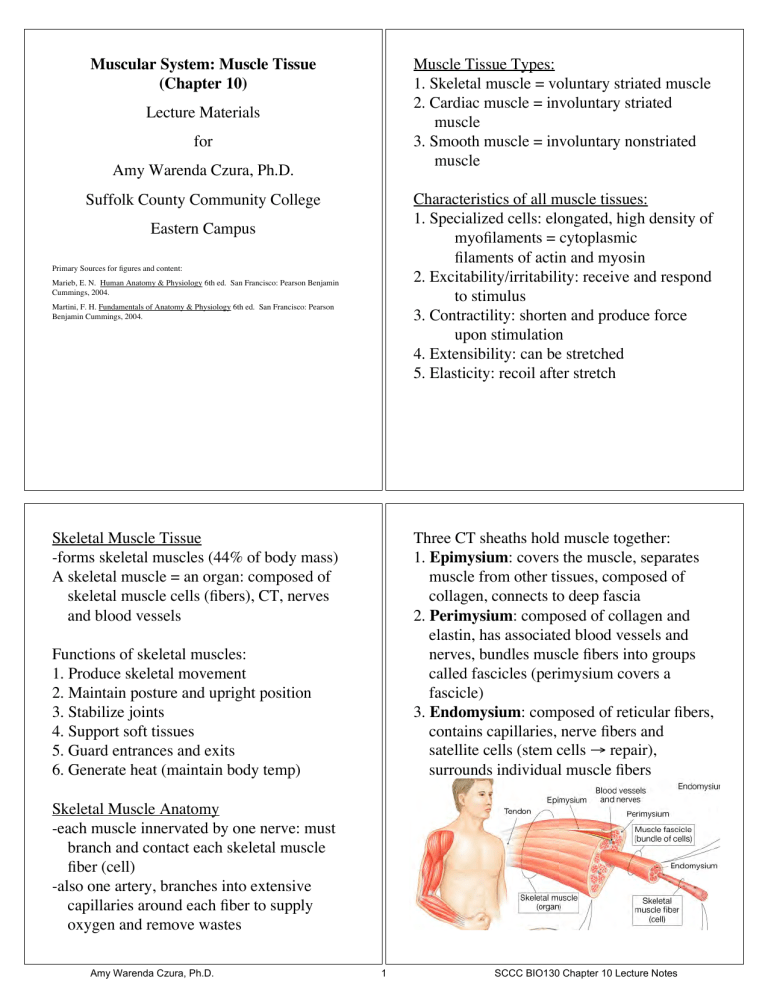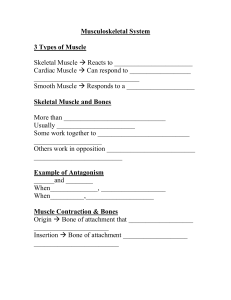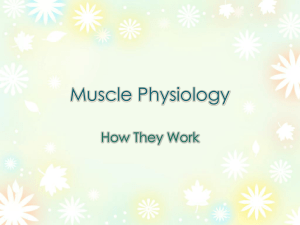BIO130Chapter10Notes
advertisement

Muscular System: Muscle Tissue (Chapter 10) Muscle Tissue Types: 1. Skeletal muscle = voluntary striated muscle 2. Cardiac muscle = involuntary striated muscle 3. Smooth muscle = involuntary nonstriated muscle Lecture Materials for Amy Warenda Czura, Ph.D. Characteristics of all muscle tissues: 1. Specialized cells: elongated, high density of myofilaments = cytoplasmic filaments of actin and myosin 2. Excitability/irritability: receive and respond to stimulus 3. Contractility: shorten and produce force upon stimulation 4. Extensibility: can be stretched 5. Elasticity: recoil after stretch Suffolk County Community College Eastern Campus Primary Sources for figures and content: Marieb, E. N. Human Anatomy & Physiology 6th ed. San Francisco: Pearson Benjamin Cummings, 2004. Martini, F. H. Fundamentals of Anatomy & Physiology 6th ed. San Francisco: Pearson Benjamin Cummings, 2004. Skeletal Muscle Tissue -forms skeletal muscles (44% of body mass) A skeletal muscle = an organ: composed of skeletal muscle cells (fibers), CT, nerves and blood vessels Three CT sheaths hold muscle together: 1. Epimysium: covers the muscle, separates muscle from other tissues, composed of collagen, connects to deep fascia 2. Perimysium: composed of collagen and elastin, has associated blood vessels and nerves, bundles muscle fibers into groups called fascicles (perimysium covers a fascicle) 3. Endomysium: composed of reticular fibers, contains capillaries, nerve fibers and satellite cells (stem cells ! repair), surrounds individual muscle fibers Functions of skeletal muscles: 1. Produce skeletal movement 2. Maintain posture and upright position 3. Stabilize joints 4. Support soft tissues 5. Guard entrances and exits 6. Generate heat (maintain body temp) Skeletal Muscle Anatomy -each muscle innervated by one nerve: must branch and contact each skeletal muscle fiber (cell) -also one artery, branches into extensive capillaries around each fiber to supply oxygen and remove wastes Amy Warenda Czura, Ph.D. 1 SCCC BIO130 Chapter 10 Lecture Notes Fibers from epimysium, perimysium and endomysium come together at ends of skeletal muscle to create attachment structure: Tendon = cord-like Aponeurosis = sheet-like -nuclei of each myoblast retained to provide enough mRNA for protein synthesis in large fiber -unfused myoblasts in adult = satellite cells -satellite cells capable of division and fusion to fiber for repair but cannot generate new fibers -cell membrane = sarcolemma -sarcolemma maintains separation of electrical charges resulting in a transmembrane potential Skeletal Muscle Fibers -huge cells: up to 100µm diameter, 30cm long -multinucleate -formed by fusion of 100s of myoblasts -Na+ pumped out of cell creating positive charge on outside of membrane -negative charge from proteins on inside give muscle fibers a resting potential of -85mV -if permeability of membrane is altered, Na+ will flow in causing change in membrane potential -change in potential will signal muscle to contract -cytoplasm = sarcoplasm: rich in glycosomes (glycogen granules) and myoglobin (binds oxygen) -fiber is filled with myofibrils extending whole length of the cell -myofibrils consist of bundles of myofilaments made of actin and myosin proteins (80% of cell volume) -tubes of sarcolemma called transverse tubules (T tubules) reach deep inside the cell to transmit changes in transmembrane potential to structures inside the cell Amy Warenda Czura, Ph.D. 2 SCCC BIO130 Chapter 10 Lecture Notes -actin makes up thin filaments -myosin makes up thick filaments -when thick and thin filaments interact, contraction occurs -triad = T-tubule wrapped around a myofibril sandwiched between two terminal cisternae of SR -triads are located near ends of a sarcomere -sarcomere = smallest functional unit of a myofibril: least amount of myofilaments necessary to produce contraction -sarcoplasm contains networks of SER called sarcoplasmic reticulum (SR) which functions to store calcium -all calcium is actively pumped from sarcoplasm to SR (SR has 1000X more Ca2+ than sarcoplasm) -triads are located repeated along length of myofilaments Sarcomere (on handout) (handout) Each myofibril = ~10thousand sarcomeres Each fiber (cell) = ~1thousand myofibrils Each fascicle = ~100muscle fibers Each muscle = ~100 fascicles Amy Warenda Czura, Ph.D. 3 SCCC BIO130 Chapter 10 Lecture Notes Thin filaments (on handout) Sliding Filament Theory -contraction of skeletal muscle is due to thick filaments and thin filament sliding past each other, not compression of the filaments -evidence: 1. H-zones and I-bands decrease width during contraction Thick filaments (on handout) 2. Zones of overlap increase width 3. Z-lines move closer together 4. A-band remains constant -sliding causes shortening of every sarcomere in every myofibril in every fiber -overall result = shortening of whole skeletal muscle Events of Muscle Contraction A. Excitation: excitation of muscle fiber is controlled by nervous system at neuromuscular junction using neurotransmitter Events of Excitation (see handout) Neuromuscular junction (on handout) Amy Warenda Czura, Ph.D. 4 SCCC BIO130 Chapter 10 Lecture Notes B. Excitation-Contraction Coupling (see handout) C. Contraction (see handout) D. Relaxation 1. Ca2+ reabsorbed by sarcoplasmic reticulum 2. Ca2+ ions detach from troponin 3. Troponin, without Ca2+, pivots tropomyosin back onto active sites on actin, no cross bridges can form 4. Sarcomeres stretch back out: -gravity -opposing muscle contractions -elastic recoil of titin protein Muscle returns to resting length Rigor Mortis: Death, ATP used up, SR can not absorb Ca2+, Ca2+ binds troponin, tropomyosin frees actin, cross bridges form, no ATP to detach myosin head = fixed cross bridge (until necrosis releases lysosomal enzymes which digest cross bridges) Diseases of muscle contraction: -Botulism/Botox: bacteria Clostridium botulinum (grows in improperly canned foods) produces botulinum toxin: toxin prevents release of Ach at neuromuscular junction, results in flaccid paralysis -Tetanus: Clostridium tetani (grows in soil) produces tetanus toxin: toxin causes over stimulation of motor neurons, results in spastic paralysis -Myasthenia gravis: autoimmune disease, causes loss of Ach receptors, muscles become non-responsive Amy Warenda Czura, Ph.D. 5 SCCC BIO130 Chapter 10 Lecture Notes Tension Production Muscle tension = force exerted by contracting muscle; force is applied to a load Load = weight of object being acted upon Frequency of Stimulation Twitch = single contraction due to single stimulus, 3 phases: For a single muscle fiber contraction is “all or none”, once contracting tension depends on: 1. Resting length of fiber 2. Frequency of stimulation Resting Length: -Greatest tension produced at optimal resting length; enough overlap that myosin can bind actin, not so much that thick filaments crash into Z-lines 1. Latent period = post stimulation but no tension: action potential moves across sarcolemma, Ca2+ released 2. Contraction phase = peak tension production: active cross bridge formation 3. Relaxation phase =decline in tension: Ca2+ reabsorbed, cross bridges decline Single twitch will not produce normal movement, requires many cumulative twitches Repeat stimulation will result in higher tension due to Ca2+ not being fully absorbed ! more cross bridges Treppe = stepping up of tension production to max level with repeat stimulation of same fiber following relaxation phase Wave summation = repeat stimulation before relaxation phase ends results in more tension production than max treppe (typical muscle contraction) Two ways to summate: 1. Incomplete tetanus: rapid cycles of contraction and relaxation produce max tension 2. Complete tetanus: relaxation eliminated, fiber in prolonged state of contraction, produces 4X more tension than maximum treppe, but quick to fatigue Most skeletal muscle ! complete tetanus when contracting Cardiac muscle ! incomplete tetanus only to prevent seizure of heart Amy Warenda Czura, Ph.D. 6 SCCC BIO130 Chapter 10 Lecture Notes Tension produced in whole muscle depends on: 1. Internal vs. external tension Internal tension = produced by sarcomeres, not all transferred to load, some lost due to elasticity of muscle tissues External tension = tension applied to load 2. Number of muscle fibers stimulated -each skeletal muscle has thousands of fibers organized into motor units -Motor unit = all fibers controlled by single motor neuron (axon branches to contact each fiber) -Number of fibers in motor unit depends on function: -fine control: 4/unit e.g. eye muscles -gross control: 2000/unit e.g. legs -Fibers from different motor units intermingled in muscle so activation of one unit will produce equal tension across whole muscle Recruitment = order of activation of motor units: slower weaker first, stronger units added to produce steady increase in tension During sustained contraction of a muscle, some units rest while others contract to avoid fatigue For maximum tension, all units in complete tetanus but this leads to rapid fatigue Muscle tone = maintaining shape/definition of muscle: some units always contracting: exercise = "units contracting "metabolic rate "speed of recruitment (better tone) All contractions produce tension but not always movement: Isotonic contractions - muscle length changes resulting in movement Isometric contractions -tension is produced with no movement -Creatine phosphokinase transfers P from CP to ADP when ATP needed to reset myosin for next contraction -Each cell has only ~20sec energy reserve At Rest: use glucose and fatty acids with O2 (from blood) !Aerobic respiration, resulting ATP used to build CP reserves, excess glucose stored as glycogen. Moderate Activity: CP used up, glucose and fatty acids with O2 (from blood) used to generate ATP (aerobic respiration). High Activity: O2 not delivered adequately, glucose from glycogen reserves used for ATP via fermentation (glycolysis only), pyruvic acid converted to lactic acid Return to resting length: expansion via: 1. elastic recoil after contraction 2. opposing muscle contractions 3. gravity Muscle Metabolism - 1 fiber ~15 billion thick filaments - 1 thick filament ~ 2500 ATP/sec - 1 glucose (aerobic respiration) = 36 ATP - each fiber needs 1 X1012 glucose/sec to contract - ATP unstable, muscles store respiration energy on creatine as Creatine Phosphate (CP) Amy Warenda Czura, Ph.D. 7 SCCC BIO130 Chapter 10 Lecture Notes Muscle Performance -Depends on: 1. Types of fibers 2. Physical conditioning Muscle Fatigue: -state where muscle can no longer contract due to: 1. Depletion of reserves (glycogen, ATP, CP) 2. Decreased pH due to lactic acid 1. Fiber Types -types of fibers in a muscle are genetically determined and mixed A. Fast glycolytic fibers (Fast twitch) -Myosin ATPases work quickly -anaerobic ATP production (glycolysis only) -large diameter fibers -more myofilaments and glycogen -few mitochondria -fast to act, powerful, but quick to fatigue -catabolize glucose only To restore function, cell needs: 1. intracellular energy reserves (glycogen, CP) 2. good circulation (nutrients in, wastes out) 3. normal O2 levels 4. normal pH Lactic Acid Disposal -lactic acid diffuses into blood -filtered out by liver -converted back to glucose -returned to blood for use by cells -when O2 returns, remaining lactic acid in muscle is converted to glucose and used in aerobic cellular respiration B. Slow oxidative fibers (slow twitch) -Myosin ATPases work slowly -specialized for aerobic respiration: -many mitochondria -extensive blood supply -myoglobin -smaller fibers for better diffusion -slow to contract, weaker tension, but resist fatigue -catabolize glucose, lipids, and amino acids 2. Physical Conditioning A. Aerobic Exercise: " capillary density " mitochondria and myoglobin both then: " efficiency of muscle metabolism " strength and stamina # fatigue B. Resistance Exercise: -results in hypertrophy: fibers increase in diameter but not number -"glycogen, myofibrils, and myofilaments results in "tension production Growth Hormone (pituitary) & testosterone (male sex hormone) stimulate synthesis of contractile proteins = muscle enlargement Epinephrine stimulates "muscles metabolism = " force of contraction Without stimulation muscles will atrophy: fibers shrink due to loss of myofilament proteins. Loss: up to ~5%/day C. Intermediate/ Fast oxidative fibers -qualities of both fast glycolytic and slow oxidative fibers -fast acting but perform aerobic respiration so resist fatigue -physical conditioning can convert some fast fibers into intermediate fibers for stamina Amy Warenda Czura, Ph.D. 8 SCCC BIO130 Chapter 10 Lecture Notes Cardiac Muscle Tissue -forms the majority of heart tissue -cells = cardiocytes -one or two nuclei -no cell division -long branched cells -myofibrils organized into sarcomeres (striated) -no triads (no terminal cisternae) -transverse tubules encircle Z-lines -aerobic respiration only -mitochondria and myoglobin rich -glycogen and lipid energy reserves -intercalated discs at cell junctions (gap junctions and desmosomes) allow transmission of action potentials & link myofibrils from one cell to next Features of cardiac muscle: 1. Can contract without neural stimulation; automaticity due to pacemaker cells that generate action potentials spontaneously 2. Pace and amount of tension can be adjusted by nervous system 3. Contractions 10X longer than skeletal muscle 4. Only twitches, no complete tetanus Smooth Muscle Tissue -lines hollow organs: regulates blood flow and movement of materials in organs -forms arrector pili muscles -usually organized into two layers: -circular -longitudinal Smooth Muscle Excitation-Contraction -different than striated muscle: no troponin so active sites on actin always exposed Events: 1. Stimulation causes Ca2+ release from SR into cytoplasm 2+ 2. Ca binds calmodulin 3. Calmodulin activates myosin light chain kinase 4. MLC Kinase converts ATP ! ADP to cock myosin head 5. Cross bridges form ! contraction, cells pull toward center Stimulation is by involuntary control from: -Autonomic Nervous System -hormones -other chemical factors (Skeletal muscle = motor neurons) (Cardiac muscle = automaticity) -spindle shaped cells -central nucleus -cells capable of division -no myofibrils, sarcomeres, or T tubules -SER / SR throughout cytoplasm -thick filaments scattered -thin filaments attached to dense bodies on desmin cytoskeleton (web) -adjacent cells attach at dense bodies with gap junctions (firm linkage and communication) -no tendons -contraction compresses whole cell Amy Warenda Czura, Ph.D. 9 SCCC BIO130 Chapter 10 Lecture Notes Effects of aging -skeletal muscle fibers become thinner #myofibrils, #energy reserves = #strength #endurance "fatigue -#cardiac and smooth muscle function = #cardiovascular performance -"fibrosis (CT) skeletal muscle less elastic -#ability to repair #satellite cells "scar formation Amy Warenda Czura, Ph.D. 10 SCCC BIO130 Chapter 10 Lecture Notes




